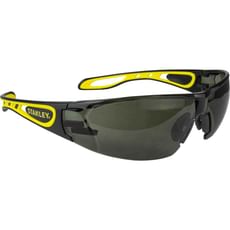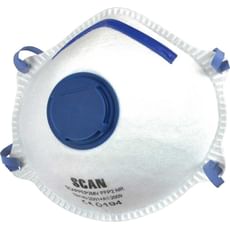Safety & Detectors
Pay in 3 interest-free payments on purchases from £30-2000 with ![]() . Learn more.
. Learn more.
 Loading...
Loading...
End of content
Error - No more pages to load
About Safety & Detectors
Workplace safety is non-negotiable, whether you're working on a busy construction site, in an industrial environment, or tackling home improvements. The Safety & Detectors category brings together essential personal protective equipment (PPE), safety monitoring devices, and protective gear designed to meet stringent UK health and safety regulations. From dust masks and hard hats to fire extinguishers and gas detectors, Tooled-Up.com stocks everything needed to create a safer working environment and comply with HSE requirements.
Professional tradespeople understand that proper safety equipment isn't just about regulatory compliance—it's about protecting yourself and colleagues from serious injury or long-term health issues. The range includes hearing protection to prevent noise-induced hearing loss, respiratory protection against harmful dust and fumes, fall arrest equipment for working at height, and detection devices that alert you to invisible dangers like carbon monoxide or combustible gases. Trusted brands from manufacturers who specialise in occupational safety ensure that every product meets or exceeds relevant British and European standards.
Whether you need basic PPE for occasional DIY projects or comprehensive safety solutions for your entire workforce, this category provides the equipment necessary to meet COSHH regulations, satisfy insurance requirements, and most importantly, get everyone home safely at the end of the day. Different trades face different hazards, which is why the selection covers everything from eye protection for metalworkers to high-visibility clothing for highway maintenance and lockout equipment for electrical isolation.
Jargon Buster
- PPE (Personal Protective Equipment) - Clothing and equipment worn to minimise exposure to hazards that cause serious workplace injuries or illnesses, including items like safety goggles, gloves, hard hats, and high-visibility vests. PPE is typically the last line of defence after other control measures.
- HSE (Health and Safety Executive) - The UK's national regulatory body responsible for workplace health and safety. HSE sets the standards and guidance that employers must follow to protect workers from harm.
- EN Standards - European Norm standards that specify minimum safety and quality requirements for PPE and safety equipment. Common examples include EN 166 for eye protection, EN 352 for hearing protection, and EN 397 for industrial safety helmets.
- COSHH (Control of Substances Hazardous to Health) - UK regulations requiring employers to control exposure to hazardous substances, including dust, fumes, chemicals, and biological agents. Compliance often requires appropriate respiratory protection and monitoring equipment.
- IP Rating (Ingress Protection) - A two-digit code indicating how well equipment is protected against solid objects and liquids. For example, IP65-rated safety detectors are dust-tight and protected against water jets, making them suitable for harsh site conditions.
- Decibel (dB) - The unit measuring sound intensity. UK regulations require hearing protection when noise levels exceed 85dB over an eight-hour period, with mandatory provision available from 80dB.
Who Uses Safety & Detectors?
Safety equipment is essential across virtually every trade and industry:
- Construction Workers & Site Managers - requiring hard hats, high-vis clothing, dust masks, and fall arrest equipment for working at height
- Electricians & Sparkies - needing lockout equipment, voltage detectors, insulated gloves, and arc flash protection
- Carpenters & Joiners - using dust masks, safety glasses, and hearing protection when operating power tools and machinery
- Plumbers & Gas Engineers - requiring gas detectors, safety goggles, and first aid kits for emergency situations
- Decorators & Painters - needing respiratory protection against fumes, eye protection from splashes, and spillage control equipment
- Facilities Managers & Building Maintenance Teams - responsible for fire extinguishers, safety signage, and carbon monoxide detectors throughout buildings
- Metalworkers & Fabricators - requiring full face shields, welding masks, and hearing defenders in noisy workshop environments
- Landscapers & Groundworkers - using ear defenders, safety boots, and high-visibility clothing near roads
- Factory & Warehouse Staff - needing various PPE depending on specific hazards present in their workplace
- DIY Enthusiasts & Homeowners - investing in basic safety equipment for home improvements, from smoke detectors to dust masks and safety glasses
How to Choose the Right Safety & Detectors
Identify Your Hazards: Start by conducting a proper risk assessment of your workplace or project. Different tasks present different dangers—cutting metal creates different risks than mixing concrete or working with chemicals. Understanding the specific hazards helps you select the right protection rather than generic equipment that might not provide adequate defence.
Check Certification and Standards: Always ensure safety equipment carries appropriate CE marking and meets relevant EN or BS standards. In the UK, PPE is classified into three categories based on risk level, with Category III covering the most serious hazards like fall protection and respiratory equipment. Don't compromise on certification—it exists for a reason.
Consider Comfort and Fit: Safety equipment only works if people actually wear it. Poorly fitting hard hats, uncomfortable ear defenders, or restrictive safety harnesses are more likely to be removed or worn incorrectly. Look for adjustable features, breathable materials, and ergonomic designs that workers can wear comfortably throughout their shift. Many manufacturers now offer PPE in multiple sizes and with features specifically designed for better all-day wearability.
Match Protection Level to Risk: Over-specifying can be as problematic as under-specifying. A basic dust mask might suffice for occasional sanding, whilst regular exposure to fine silica dust requires a properly fitted respirator with P3 filters. Similarly, working at 2 metres might only need a simple restraint lanyard, whilst roofing work demands a full body harness with energy-absorbing lanyards and appropriate anchor points.
Think About Detection Needs: For safety detectors, consider what you need to monitor. Carbon monoxide detectors are essential where fuel-burning appliances are present, whilst multi-gas detectors are necessary for confined space work. Look for devices with clear alarms (both audible and visual), easy calibration, and appropriate battery life for your working patterns. Many modern detectors offer data logging capabilities, which can be valuable for compliance documentation.
Plan for Maintenance and Replacement: Safety equipment has a limited lifespan. Filters need changing, batteries require replacement, and items subjected to impact or contamination must be retired. Factor in ongoing costs and availability of replacement parts when making your initial purchase. Some items, like hard hats, should be replaced every five years even without visible damage, as UV exposure degrades the material.
Popular Accessories
- Replacement Filters and Cartridges - essential consumables for respiratory protection equipment, available in various ratings for different contaminants including dust, gas, and vapour
- Helmet Accessories - including visors, ear defender attachments, and chin straps to adapt hard hats for specific tasks and improve versatility
- Storage Solutions - wall-mounted brackets for fire extinguishers, first aid cabinets, and PPE storage units to keep safety equipment organised and accessible
- Spare Batteries and Calibration Kits - for safety detectors to ensure continuous operation and accurate readings
- Lens Cleaning Products - anti-fog sprays and cleaning wipes to maintain clear vision through safety eyewear and face shields
- Adhesive Fixings - for mounting safety signs, mirrors, and smoke detectors without drilling in rental properties or finished surfaces
- High-Visibility Accessories - reflective armbands, sashes, and helmet bands to enhance visibility in low-light conditions
Safety Information
Legal Requirements: UK employers have a legal duty under the Health and Safety at Work Act 1974 to provide appropriate PPE free of charge to employees. Self-employed tradespeople are responsible for providing their own equipment. Specific regulations like the PPE at Work Regulations 1992 and the Construction (Head Protection) Regulations 1989 mandate certain protection in particular circumstances. Failure to comply can result in prosecution, substantial fines, and invalidated insurance claims.
Training and Proper Use: Simply providing safety equipment isn't enough—users must receive proper training in its correct use, limitations, and maintenance. A safety harness incorrectly worn provides no protection, whilst an improperly fitted respirator allows contaminants to bypass the filter. Ensure everyone understands how to inspect equipment before use, recognise when it needs replacing, and know its limitations.
Regular Inspection and Testing: Safety equipment must be regularly inspected and maintained. Fall arrest equipment requires thorough examination by a competent person at least annually, fire extinguishers need servicing, and detectors require calibration and testing. Keep records of all inspections and maintenance—they're essential for demonstrating compliance and may be required by your insurance provider.
Never Compromise on Safety: Damaged, expired, or inadequate safety equipment is worse than none at all—it creates a false sense of security. If a hard hat has taken an impact, it must be replaced immediately even without visible damage. If a detector fails its bump test, it cannot be used until properly serviced. Safety equipment represents a tiny fraction of project costs but protects your most valuable asset—people.
Frequently Asked Questions
How often should I replace my hard hat or safety helmet?
Most manufacturers recommend replacing hard hats every five years from the date of manufacture, regardless of visible wear. However, helmets should be replaced immediately if they've sustained any impact, show signs of cracking, have been exposed to chemicals, or the suspension system is damaged. Check the manufacturing date stamped inside the helmet—UV exposure from sunlight gradually degrades the protective properties of the shell material even without obvious damage.
What type of dust mask do I need for different materials?
This depends on the material you're working with. Basic FFP1 masks (or disposable dust masks) suit nuisance dust from sanding wood. FFP2 masks are required for moderate levels of fine dust. For hazardous materials like silica dust from concrete or stone, or asbestos work, you need FFP3-rated respirators as a minimum. For regular exposure to fine dust, consider a reusable half-mask respirator with replaceable P3 filters, which offers better protection, comfort, and long-term economy. Always check COSHH assessments for specific material requirements.
Do I legally need to wear safety equipment for DIY projects at home?
Whilst health and safety legislation primarily applies to workplaces, the same hazards exist in DIY projects—flying debris, harmful dust, noise, and falls don't distinguish between professional and amateur work. Though not legally required for homeowners working on their own property, safety equipment is strongly recommended. Your home insurance may not cover injuries resulting from negligent failure to use appropriate protection, and some conditions like noise-induced hearing loss or respiratory damage from dust exposure are permanent and irreversible.
How do I know if safety equipment meets UK standards?
Look for CE marking on the product, which indicates compliance with European health, safety, and environmental protection standards (still recognised in the UK). PPE should also display the relevant EN standard number—for example, EN 397 for industrial safety helmets or EN 166 for eye protection. Category III PPE (for serious risks) must have been type-examined by an approved body, whose identification number appears alongside the CE mark. Browse the selection at Tooled-Up.com where certification information is clearly displayed, and conformity documentation can be requested if required for site compliance records.
What's the difference between detection and protection equipment?
Detection equipment identifies hazards—carbon monoxide detectors, gas monitors, voltage testers, and moisture metres warn you of dangers you cannot see, smell, or hear. Protection equipment shields you from hazards—masks, goggles, gloves, and harnesses create a barrier between you and harm. Both are essential components of workplace safety: detectors alert you to risks so you can take action, whilst PPE protects you when exposure cannot be completely eliminated. Many situations require both—for example, a gas detector to identify leaks and a respirator for protection when entering a contaminated space.




































